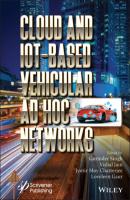Cloud and IoT-Based Vehicular Ad Hoc Networks. Группа авторов
Чтение книги онлайн.

Читать онлайн книгу Cloud and IoT-Based Vehicular Ad Hoc Networks - Группа авторов страница 22
Название: Cloud and IoT-Based Vehicular Ad Hoc Networks
Автор: Группа авторов
Издательство: John Wiley & Sons Limited
Жанр: Автомобили и ПДД
isbn: 9781119761822
isbn:
2.6 Performance Evaluation Metrics for Service
Discovery Mechanism in the 5G-VANET Milieu
The petty important performance evaluation metrics which are used to measure the performances of the service discovery mechanism in the 5G-VANET milieu are vehicle user to target delay, success rate, response time, average bandwidth consumption, delivery ratio, packet order ratio, collision ratio, and duplicate packets ratio. The performance evaluation metrics are stated in the definition:
Vehicle User-To-Target Delay: The vehicle user-to-target delay determines the delay in terms of milliseconds from sender to receiver. It includes the queuing delay, processing time, and retransmission delay.
Success Rate (SR): SR determines the failed and successful transactions. Response Time: A response time determines the average time consumption between the response and request.
Average Bandwidth Consumption: It calculates the average bandwidth consumption for a single transaction.
Delivery Ratio: Delivery ratio is calculated by packets delivered to the packet sent, in terms of numbers. It determines the number of successful delivery of packets.
Packet Order Ratio: The packet order ratio determines the received packet order.
Collision Ratio: The collision ratio is calculated by packets collided to the packets sent in numbers.
Duplicate Packets Ratio: The duplicate packets ratio is calculated by determining the duplicate packets at the destination, estimated in numbers.
2.7 The Advantage of Service Discovery in the 5G-VANET Milieu
By integrating the 5G with VANET will not only affords the vehicle users with seamless connectivity but also endorse a glut of a new application.
The 5G-VANET users can enjoy the high data rate with low latency.
The 5G-VANET users can enjoy the voice streaming video and interactive multimedia without any intermittent.
5G enhances the discovery procedures in a VANET milieu by affording high reliability and low latency.
2.8 The Disadvantage of Service Discovery in the 5G-VANET Milieu
5G-VANET milieu technology is still in research and development.
The 5G-VANET milieu infrastructure is a high cost.
The affording the security and privacy in the 5G-VANET milieus is a major task.
Protecting the service consumers and providers from security attacks is another major issue in the discovery procedures.
2.9 Future Enhancement and Research Directions
The technological infrastructure such as vehicles to everything and vehicle to infrastructure communications modes can be enhanced.
The Intelligent Transportation System (ITS) performance can be enhanced.
To afford proficient centralized management via software units, the Software Defined Network (SDN) can be integrated with the service discovery architecture for 5G-VANET milieu [31, 32].
The various protocols have arisen for the discovery process in the VANET milieu and they vary substantially in terms of architecture, interface styles, languages, the message form, and so on. As such, middleware is necessary to enable the discovery processes on different milieu and to create compatibility among heterogeneous discovery. In future the efficient heterogeneous middleware has to be developed.
As VANET milieu is dynamic, to higher the reliability and lower the latency, the two expertise technologies such as SDN and Network Functions Virtualization (NFV) can be used for network slicing.
Machine learning methods can be used to analyze a large amount of data by acquiring knowledge from VANET milieu and can make cognitive decisions.
The field evaluation with more real-time and practical scenarios can be carried out.
2.10 Conclusions
Service discovery is the most important mechanism for applications-oriented VANET milieu. In recent days, the Internet of Things-based VANET milieu has attracted the research community, which increases the interest in the service discovery mechanism. The service discovery process in the 5G-VANET milieu dynamically discovers the services according to the requirements of the vehicular user. This paper conducted a little study on the service discovery mechanism in the 5G-VANET milieu. In order to increase the bandwidth and to lower the latency in the service discovery process, the VANET makes use of 5G technologies. Initially, this chapter discusses the fundamentals and technological details of VANET, 5G, the need of integrating the VANET with 5G, and the need for service discovery in the 5G-VANET milieu. This chapter also gives the architectural model of the service discovery mechanism in the 5G-VANET milieu. Finally, this chapter discusses the advantages and disadvantages of the service discovery mechanisms using 5G technology in VANET milieu and also gives future directions for upcoming researchers.
References
1. Kumar, A., Payal, M., Dixit, P., Chatterjee, J.M., Framework for Realization of Green Smart Cities Through the Internet of Things (IoT), in: Trends in Cloud-based IoT, EAI/Springer Innovations in Communication and Computing, F. Al-Turjman (Ed.), Springer, Cham, 2020.
2. Sujatha, R., Nathiya, S., Chatterjee, J.M., Clinical Data Analysis Using IoT Data Analytics Platforms, in: Internet of Things Use Cases for the Healthcare Industry, pp. 271–293, Springer, Cham, 2020.
3. Dharanyadevi, P. and Venkatalakshmi, K., Potent Gateway Selection Algorithm for Integrated 3G-VMesh Milieu. World Appl. Sci. J., 33, 7, 1228–1233, 2015.
4. Dharanyadevi, P. and Venkatalakshmi, K., Reliable and Scalable Routing Protocol (RSRP) for Multimedia Data Transmission in Vehicular Mesh Milieu. Int. J. Appl. Eng. Res. (IJAER), 9, 23, 19935–19946, 2014.
5. Dharanyadevi, P. and Venkatalakshmi, K., Persuasive Gateway and eNB Selection Algorithm For 4G-VMesh Networ. Aust. J. Basic Appl. Sci., 11, 11, 118–121, 2017.
6. ShahidAnwer, M., A Survey of VANET Technologies. J. Emerging Trends Comput. Inf. Sci., 5, 9, 661–671, September 2014.
7. Dharanyadevi, P. and Venkatalakshmi, K., Proficient MMINS Algorithm in Integrated VANET-4G Milieu. Eur. J. Appl. Sci., 8, 4, 214–224, 2016.
8. Dharanyadevi, P. and Venkatalakshmi, K., Proficient routing by adroit algorithm in 5G-Cloud-VMesh network. EURASIP J. Wirel. Commun. Netw., 89, 1–11, 2016.
9. Liu, Y., Zhang, Y., Yu, R., Xie, S., Integrated Energy and Spectrum Harvesting For 5G Wireless Communications. IEEE Network, 29, 3, 75–81, 2015.
10. СКАЧАТЬ